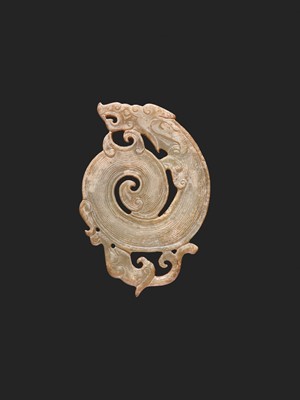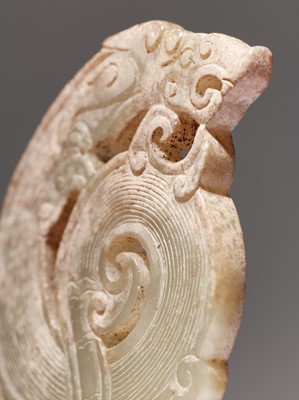27th Jan, 2022 10:00
Asian Art Discoveries
241
A WELL-DETAILED CARVING OF A DRAGON AND A PHOENIX IN PALE GREEN JADE
Sold for €8,216
including Buyer's Premium
Jade. China, late Eastern Zhou, early Western Han period, 3rd - 2nd century BC
The rounded, dynamic shape of this well-carved and finely detailed ornament is based on the design of a dragon whose coiled body terminates in the head of a long-crested phoenix.
Jades displaying such a configuration of dragons and phoenixes merging together started to be crafted in the Eastern Zhou period and remained in use under the Han dynasty. The bodies of the dragon and the phoenix join at the centre, where they seem to fuse in a single, continuous, graceful line. The curl in the middle, separated from the coiled body of the dragon by a cut-out, stands for both the tip of the dragon’s tail as well as the wings of the bird. The bodies of the two mythical animals are differentiated: the dragon’s is filled with tight, parallel lines that stress its curvature, while that of the phoenix is polished and simply decorated with pairs of incised lines.
The heads are also finely detailed and vividly express the essence of the two animals: the dragon, with feline-like features, is vigorous and powerful, and the phoenix, gentle and graceful. The lovely celadon coloured jade is translucent, with very few black speckles that are mostly located on the inside of the cut-out areas and where there are small nicks. Examples of Eastern Zhou pendants carved as dragons and phoenixes sharing the same body are in the Harvard Art Museums, accession numbers 1943.50.433/435/447/451/468. They are published in M. Loehr and L.G. Fitzgerald Huber, Ancient Chinese jades from the Grenville L. Winthrop collection in the Fogg Art Museum, Cambridge 1975, nos.424-428. Compare also the pendant illustrated in F. Salviati, 4000 Years of Chinese Archaic Jades, Edition Zacke, Vienna 2017, no.257 and the pendant auctioned at Galerie Zacke on 10 March 2018, no.40.
LENGTH 7.5 cm - WIDTH 5.5 cm
Provenance: From an old Austrian collection.
Jade. China, late Eastern Zhou, early Western Han period, 3rd - 2nd century BC
The rounded, dynamic shape of this well-carved and finely detailed ornament is based on the design of a dragon whose coiled body terminates in the head of a long-crested phoenix.
Jades displaying such a configuration of dragons and phoenixes merging together started to be crafted in the Eastern Zhou period and remained in use under the Han dynasty. The bodies of the dragon and the phoenix join at the centre, where they seem to fuse in a single, continuous, graceful line. The curl in the middle, separated from the coiled body of the dragon by a cut-out, stands for both the tip of the dragon’s tail as well as the wings of the bird. The bodies of the two mythical animals are differentiated: the dragon’s is filled with tight, parallel lines that stress its curvature, while that of the phoenix is polished and simply decorated with pairs of incised lines.
The heads are also finely detailed and vividly express the essence of the two animals: the dragon, with feline-like features, is vigorous and powerful, and the phoenix, gentle and graceful. The lovely celadon coloured jade is translucent, with very few black speckles that are mostly located on the inside of the cut-out areas and where there are small nicks. Examples of Eastern Zhou pendants carved as dragons and phoenixes sharing the same body are in the Harvard Art Museums, accession numbers 1943.50.433/435/447/451/468. They are published in M. Loehr and L.G. Fitzgerald Huber, Ancient Chinese jades from the Grenville L. Winthrop collection in the Fogg Art Museum, Cambridge 1975, nos.424-428. Compare also the pendant illustrated in F. Salviati, 4000 Years of Chinese Archaic Jades, Edition Zacke, Vienna 2017, no.257 and the pendant auctioned at Galerie Zacke on 10 March 2018, no.40.
LENGTH 7.5 cm - WIDTH 5.5 cm
Provenance: From an old Austrian collection.
Zacke Live Online Bidding
Our online bidding platform makes it easier than ever to bid in our auctions! When you bid through our website, you can take advantage of our premium buyer's terms without incurring any additional online bidding surcharges.
To bid live online, you'll need to create an online account. Once your account is created and your identity is verified, you can register to bid in an auction up to 12 hours before the auction begins.
Intended Spend and Bid Limits
When you register to bid in an online auction, you will need to share your intended maximum spending budget for the auction. We will then review your intended spend and set a bid limit for you. Once you have pre-registered for a live online auction, you can see your intended spend and bid limit by going to 'Account Settings' and clicking on 'Live Bidding Registrations'.
Your bid limit will be the maximum amount you can bid during the auction. Your bid limit is for the hammer price and is not affected by the buyer’s premium and VAT. For example, if you have a bid limit of €1,000 and place two winning bids for €300 and €200, then you will only be able to bid €500 for the rest of the auction. If you try to place a bid that is higher than €500, you will not be able to do so.
Online Absentee and Telephone Bids
You can now leave absentee and telephone bids on our website!
Absentee Bidding
Once you've created an account and your identity is verified, you can leave your absentee bid directly on the lot page. We will contact you when your bids have been confirmed.
Telephone Bidding
Once you've created an account and your identity is verified, you can leave telephone bids online. We will contact you when your bids have been confirmed.
Classic Absentee and Telephone Bidding Form
You can still submit absentee and telephone bids by email or fax if you prefer. Simply fill out the Absentee Bidding/Telephone bidding form and return it to us by email at office@zacke.at or by fax at +43 (1) 532 04 52 20. You can download the PDF from our Upcoming Auctions page.
How-To Guides
How to Create Your Personal Zacke Account
How to Register to Bid on Zacke Live
How to Leave Absentee Bids Online
How to Leave Telephone Bids Online
中文版本的操作指南
创建新账号
注册Zacke Live在线直播竞拍(免平台费)
缺席投标和电话投标
Third-Party Bidding
We partner with best-in-class third-party partners to make it easy for you to bid online in the channel of your choice. Please note that if you bid with one of our third-party online partners, then there will be a live bidding surcharge on top of your final purchase price. You can find all of our fees here. Here's a full list of our third-party partners:
- 51 Bid Live
- EpaiLive
- ArtFoxLive
- Invaluable
- LiveAuctioneers
- the-saleroom
- lot-tissimo
- Drouot
Please note that we place different auctions on different platforms. For example, in general, we only place Chinese art auctions on 51 Bid Live.
Bidding in Person
You must register to bid in person and will be assigned a paddle at the auction. Please contact us at office@zacke.at or +43 (1) 532 04 52 for the latest local health and safety guidelines.




